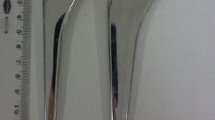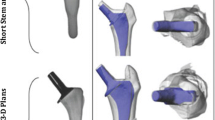Abstract
Purpose
Taper fluted and cylindrical femoral stems have been commonly used for revision surgery with femoral bone loss. Shape and material differences between taper fluted and cylindrical confused surgeons whether superiority and inferiority in comparisons especially for type IIIB Paprosky bone deficiency. This study aims to investigate the micromotion between implant and bone interface and stress distribution around the implant in human cadaveric experiments.
Methods
Paired comparisons of 7 cadavers between taper fluted stem and cylindrical stem were tested under dynamic cyclic loading.
Results
The results showed appropriate bone-implant micromotions for bone osteointegration could be observed between both taper fluted and cylindrical stems (85 ± 10 μm and 113 ± 80 μm respectively, p = 0.59). Taper fluted stem attained the load distribution from the proximal to distal surrounding bone (from 4.92 ± 2.87 MPa to 2.14 ± 1.43 MPa, p = 0.43), while the cylindrical stem type showed the proximal bone stress shielding (from 2.56 ± 0.76 MPa to 5.23 ± 0.77 MPa, p = 0.03).
Conclusion
Both taper fluted and cylindrical femoral stems provided an adequate initial stability with a proper micromotions for bone-implant osteointegration for type IIIB Paprosky femoral bone loss. The taper fluted femoral stem had better biomechanical advantage in terms of greater stress transfer to periprosthetic bone.





Similar content being viewed by others

References
Sloan M, Premkumar A, Sheth NP (2018) projected volume of primary total joint arthroplasty in the U.S., 2014 to 2030. J Bone Joint Surg Am 100(17):1455–1460
Gwam CU, Mistry JB, Mohamed NS, Thomas M, Bigart KC, Mont MA et al (2017) Current epidemiology of revision total hip arthroplasty in the United States: national inpatient sample 2009 to 2013. J Arthroplasty 32(7):2088–2092
Badarudeen S, Shu AC, Ong KL, Baykal D, Lau E, Malkani AL (2017) Complications after revision total hip arthroplasty in the medicare population. J Arthroplasty 32(6):1954–1958
Sakellariou VI, Babis GC (2014) Management bone loss of the proximal femur in revision hip arthroplasty: update on reconstructive options. World J Orthop 5(5):614–622
Paprosky WG, Aribindi R (2000) Hip replacement: treatment of femoral bone loss using distal bypass fixation. Instr Course Lect 49:119–130
Kwong LM, Miller AJ, Lubinus P (2003) A modular distal fixation option for proximal bone loss in revision total hip arthroplasty: a 2- to 6-year follow-up study. J Arthroplasty 18(3 Suppl 1):94–97
Palumbo BT, Morrison KL, Baumgarten AS, Stein MI, Haidukewych GJ, Bernasek TL (2013) Results of revision total hip arthroplasty with modular, titanium-tapered femoral stems in severe proximal metaphyseal and diaphyseal bone loss. J Arthroplasty 28(4):690–694
Kang JS, Moon KH, Park SR, Choi SW (2010) Long-term results of total hip arthroplasty with an extensively porous coated stem in patients younger than 45 years old. Yonsei Med J 51(1):100–103
Ngu AWT, Rowan FE, Carli AV, Haddad FS (2019) Single 3° tapered fluted femoral stems demonstrate low subsidence at mid-term follow-up in severe bony deficiency. Ann Transl Med 7(23):725
Abdelsamie KR, Elhawary I, Ali H, Ali M, El-Shafie M, Dominic Meek RM (2020) Outcomes of modular femoral revision implants and the effect of component design on subsidence. Bone Joint J 102-b(6):709–15
Kosmopoulos V, Russell RD, Rodrigues DC, Bucci G, Huo MH (2020) Tapered stem geometry provides superior initial fixation stability to cylindrical stem geometry in the setting of severe bone loss: a finite element analysis. Eng Rep 2:e12218
Zhang Y, Zhang Y, Sun J-N, Hua Z-J, Chen X-Y, Feng S (2020) Comparison of cylindrical and tapered stem designs for femoral revision hip arthroplasty. BMC Musculoskelet Disord 21(1):1–11
Russell RD, Pierce W, Huo MH (2016) Tapered vs cylindrical stem fixation in a model of femoral bone deficiency in revision total hip arthroplasty. J Arthroplasty 31(6):1352–1355
Kirk K, Potter B, Lehman R, Xenos J (2007) Effect of distal stem geometry on interface motion in uncemented revision total hip prostheses. Am J Orthop 36:545–549
Sporer SM, Paprosky WG (2003) Revision total hip arthroplasty: the limits of fully coated stems. Clin Orthop Relat Res 417:203–209
Aribindi R, Barba M, Solomon MI, Arp P, Paprosky W (1998) Bypass fixation. Orthop Clin North Am 29(2):319–329
Ellenrieder M, Souffrant R, Schulze C, Mittelmeier W, Bader R (2020) Micromotion and subsidence of a cementless conical fluted stem depending on femoral defect size—a human cadaveric study. Clin Biomech 80:105202
Engh CA, O’Connor D, Jasty M, McGovern TF, Bobyn JD, Harris WH (1992) Quantification of implant micromotion, strain shielding, and bone resorption with porous-coated anatomic medullary locking femoral prostheses. Clin Orthop Relat Res 285:13–29
Pilliar RM, Lee JM, Maniatopoulos C (1986) Observations on the effect of movement on bone ingrowth into porous-surfaced implants. Clin Orthop Relat Res 208:108–113
Kohli N, Stoddart JC, van Arkel RJ (2021) The limit of tolerable micromotion for implant osseointegration: a systematic review. Sci Rep 11(1):10797
Picado CHF, Savarese A, Cardamoni VDS, Sugo AT, Garcia FL (2020) Clinical, radiographic, and survivorship analysis of a modular fluted tapered stem in revision hip arthroplasty. J Orthop Surg 28(1):2309499019891638
Revision Total Hip Arthroplasty Study Group (2013) A comparison of modular tapered versus modular cylindrical stems for complex femoral revisions. J Arthroplasty 28(8 Suppl):71–3
Acknowledgements
The authors would like to express their sincere thanks to Zimmer Biomet Thailand for prostheses donation in this experiment. Aside from the donation, Zimmer Biomet Thailand was not involved in study design, data analysis and interpretation, or manuscript writing and submittal decision. The authors would like to thank the Cadaveric Surgical Training Center, Faculty of Medicine, Chiang Mai University for providing the cadavers used in this study (ORT-2560-04644).
Author information
Authors and Affiliations
Corresponding author
Ethics declarations
Conflict of interest
None.
Additional information
Publisher's Note
Springer Nature remains neutral with regard to jurisdictional claims in published maps and institutional affiliations.
Rights and permissions
Springer Nature or its licensor (e.g. a society or other partner) holds exclusive rights to this article under a publishing agreement with the author(s) or other rightsholder(s); author self-archiving of the accepted manuscript version of this article is solely governed by the terms of such publishing agreement and applicable law.
About this article
Cite this article
Limmahakhun, S., Adulkasem, N., Rungsiyakull, C. et al. Micromotion and stress shielding between taper fluted and cylindrical femoral stems for Paprosky bone deficiency type IIIB. Musculoskelet Surg 107, 391–396 (2023). https://doi.org/10.1007/s12306-023-00781-2
Received:
Accepted:
Published:
Issue Date:
DOI: https://doi.org/10.1007/s12306-023-00781-2



